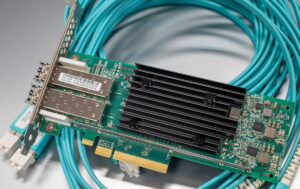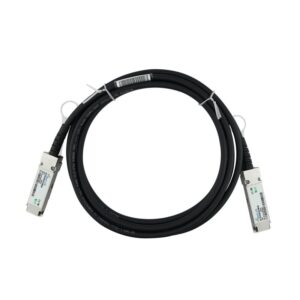
In high-speed data transmission, the choice of cables plays a pivotal role in determining the efficiency and reliability of network systems. Among the various options available, Fiber Channel and ARZB QSFP cables stand out as prominent contenders. This article delves into the comparative analysis of these two technologies, highlighting their features, advantages, and optimal usage scenarios.
Understanding Fiber Channel
Fiber Channel (FC) is a high-speed network technology primarily used for storage networking. It facilitates data transfer between storage systems, servers, and other computing devices. Developed in the late 1980s, channel fibre has evolved over the decades to support higher speeds and more efficient data transmission.

Key Features of Fiber Channel
1. High-Speed Data Transfer: Fiber Channel supports data transfer speeds ranging from 1 Gbps to 128 Gbps, making it suitable for environments that demand high bandwidth.
2. Low Latency: FC is known for its low latency, which is crucial for applications that require real-time data processing and minimal delay.
3. Reliability: With a robust error detection and correction mechanism, Fiber Channel ensures reliable data transmission, which is vital for mission-critical applications.
4. Scalability: Fiber Channel networks can be easily scaled to accommodate growing data needs without compromising performance.
5. Security: FC networks offer advanced security features, including zoning and Logical Unit Number (LUN) masking, to safeguard data against unauthorized access.
Understanding ARZB QSFP Cables
The arzb qsfp is a type of high-speed cable used for data center and high-performance computing (HPC) applications. ARZB cables integrate active electrical components to convert electrical signals into optical signals and vice versa, ensuring efficient data transmission over longer distances.

Key Features of ARZB QSFP Cables
1. High Bandwidth: ARZB QSFP cables support data transfer rates up to 400 Gbps, making them ideal for data-intensive applications.
2. Extended Reach: Unlike traditional copper cables, ARZB cables can transmit data over longer distances without signal degradation, with typical ranges of up to 100 meters.
3. Flexibility and Weight: ARZB cables are lightweight and flexible, facilitating easier installation and management in data centers with dense cabling environments.
4. Energy Efficiency: ARZB cables consume less power compared to other high-speed interconnects, contributing to energy savings in large-scale data centers.
5. Plug and Play: These cables are designed for easy deployment, with minimal configuration required, reducing the complexity and cost of installation.
Comparative Analysis
Performance
When it comes to performance, both Fiber Channel and ARZB QSFP cables offer high-speed data transmission. However, ARZB QSFP cables have an edge with their support for data rates up to 400 Gbps, compared to Fiber Channel’s maximum of 128 Gbps. This makes ARZB QSFP cables more suitable for extremely data-intensive applications such as high-performance computing and large-scale data centers.
Latency
Fiber Channel is renowned for its low latency, which is critical for applications requiring real-time data processing, such as financial transactions and database management. While ARZB QSFP cables also offer low latency, Fiber Channel’s specialized architecture often provides a slight advantage in latency-sensitive environments.
Distance
One of the significant advantages of ARZB QSFP cables is their ability to transmit data over longer distances without signal degradation. With ranges up to 100 meters, ARZB cables are ideal for connecting devices across large data centers. In contrast, the Fiber Channel’s effective range is typically shorter, requiring repeaters or additional infrastructure for long-distance connections.
Scalability
Both technologies are scalable, but Fiber Channel’s modular nature allows for easier expansion within storage area networks (SANs). ARZB QSFP cables, while scalable, may require more planning and infrastructure changes to accommodate significant growth.
Reliability and Security
Fiber Channel excels in reliability and security, with robust mechanisms for error detection, correction, and advanced security features. ARZB QSFP cables, while reliable, may not offer the same level of built-in security, making them more suitable for environments where data security is managed at higher network layers.
Cost
Cost considerations often influence the choice between Fiber Channels and ARZB QSFP cables. Fiber Channel infrastructure, including switches and storage devices, can be more expensive to implement and maintain. On the other hand, ARZB QSFP cables, while potentially costly upfront, may offer savings in power consumption and ease of installation.
Optimal Usage Scenarios
Fiber Channel
Storage Area Networks (SANs): Fiber Channel is the preferred choice for SANs due to its high reliability, low latency, and robust security features.
Financial Services: Applications that require real-time data processing, such as trading platforms, benefit from Fiber Channel’s low latency.
Enterprise Data Centers: Organizations with existing Fiber Channel infrastructure can continue to leverage its scalability and performance for growing data needs.
AOC QSFP Cables
High-Performance Computing (HPC): ARZB QSFP cables are ideal for HPC environments that require ultra-high bandwidth and low latency over extended distances.
Large-Scale Data Centers: Data centers that need to connect devices across long distances without signal degradation benefit from ARZB QSFP cables.
Cloud Service Providers: The flexibility, weight, and power efficiency of ARZB QSFP cables make them suitable for cloud service providers aiming to optimize data transmission and reduce operational costs.
Conclusion
In conclusion, the choice between Fiber Channel and ARZB QSFP cables hinges on specific application requirements and infrastructure considerations. Fiber Channel remains a robust solution for environments demanding high reliability, low latency, and advanced security, particularly in SANs and financial services. Conversely, ARZB QSFP cables excel in scenarios requiring high bandwidth, extended reach, and energy efficiency, making them ideal for HPC and large-scale data centers.
By understanding the strengths and limitations of each technology, organizations can make informed decisions to optimize their network performance and support their evolving data needs.




